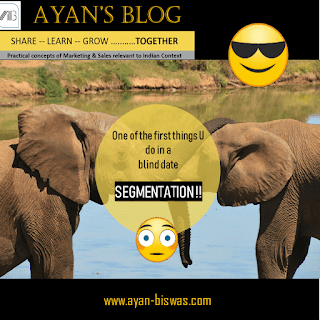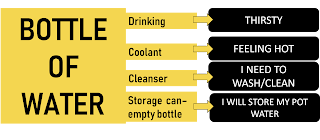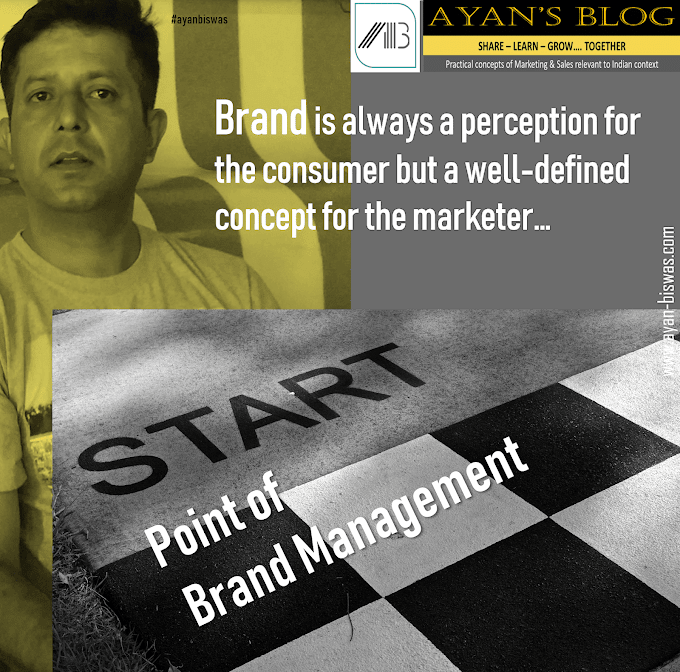Segmentation…. Targeting…. Positioning…. woooh…. that’s the Bible of Marketing…. fundamentals/basics/must know etc. etc…the synonyms are endless….😆
 |
Segmentation…. Targeting…. Positioning…. that’s the Bible of Marketing
|
Segmentation…Targeting…Positioning… Bible of Marketing
Well, to
tell you…. yes, it is…. 👍 but then there is one more
department which is closely related to Marketing…. that does that STP as
frequently as the marketers sitting @ HO do… 😧. What we
study in MBA books during our management courses ……maximum of us generally
forget by the time we are around 5 years old in the industry….like how many of
us still remember… sales is a part of marketing….how many organizations recruit
as per that….how may careers progress as per that….to say it’s very less…..😄Similarly, many of us also have forgotten about STP is not the
only child of marketing...!!...even worst…. majority of the management books & courses don’t focus on this
topic…. although in industry its practiced almost regularly… 😨😇….
To keep it
simple & easy to understand, let’s just briefly touch upon STP in marketing
(there is already enough written on it) & then move on to the STP in the
other function. To gain a better understanding of the overall STP in marketing,
we divide the businesses into 2 types….1st B2B business (both online & offline)
….2nd…other businesses… (both offline & online)..which includes
distribution based channel business, business directly with consumer. We start
with other businesses first & then come to B2B for a quicker & crisper
approach 👍
So, its
other businesses except B2B first…… (both offline & online) ….
 |
| Segmentation on a Blind Date!! |
Have you ever been to a blind date...??😜…..Yes…👍…No 😔…..its ok in both cases….👍…...in a blind date you meet a person whom you have not seen before (either in person or pic)….but may/mayn’t have spoken to him/her….say for ex….over phone. So effectively, you don’t know how the person looks & you plan to meet that person-...so what many of us do….ask for a description of the person…(in terms of height, skin color, hair color, what he/she is wearing etc. etc.) & sometimes also tell the person to stand by a landmark(say below this bridge…or…@ this restaurant….or….near to the booking office @ airport/railway station etc. etc.)
Have you
ever wondered what we are doing…!!.... we are trying a identify a person by
his/her profile (physical characteristic like height, dress etc. &
location bridge, restaurant etc.). Why are we doing this….?. because there are
many other people around.…among which we must identify our blind-date….so we
develop a profile of the blind-date to identify him/her.
This is like
segmentation in marketing. You identify that profile of people (who can be your customers) from
group of entire population of the world…!! Ok, now you did profile up your
blind-date based on clothes, looks , height, hair color, location etc. etc.….how
do you profile in marketing for segmentation….it’s by customer needs…..as
the basic premise is….one will buy a product only when one needs it….(need may
not be so intense a word as it sounds….I may just abruptly buy a chocolate
without wanting to eat it….but I bought because I just felt so….so feeling is
the need here!!..👍
Although
there are many models to do the segmentation, the one I find simplest &
easiest to understand is:
Feature - Benefit of product
 |
| Feature- Benefit - Need |
Feature of a product--- Gives a Benefit to the consumer; It’s a benefit because it serves a need- Those needs are the segments
One 'Feature' may give rise to multiple 'Benefits'
Multiple 'Features' may give rise to one'Benefit'
One 'Benefit' may satisfy multiple 'Needs'
Multiple 'Benefits' may serve one 'Need'
 |
| Segmentation-Targeting-Positioning |
For Eg: A bottle of water - People may buy water to drink water, to wash their hand's & face to relieve from heat, to wash utensils etc..). The bottle is used for storage (bigger SKUs like 25 lts.).
 |
| Segmentation-Targeting-Positioning |
The basic
premise is products have features to provide a benefit to the consumer, which
will be benefit if & only if it serves some need, those needs are the
segments for the product. Which effectively means…. that person who is not in
the segmentation for your products, potentially won’t ever buy your product.
For ex: a person who doesn’t have hairs wont land up buying a comb or say a
person whose legs are amputed won’t probably buy shoes.
Infact, this is the tool (simplistic representation) used for Product Design & development by R&D/Design (in reverse way)....when the marketing/consumer insight/sales comes up with the need/benefit required (latent or visible consumer demand) and the R&D/Design correspondingly comes up with the required feature/product to serve the benefit/need😃
Does that
above format help you to segment??...the answer is NO… 😱…why…because
there are still many people who fall in that bracket…like there will be huge
number of people who has short-sightedness/long-sightedness. So, after the
initial format of grouping user types (as per the format described above), the
next stage of segmentation in marketing is to further profile it in groups
which are smaller & can be tracked...!!
Segmentation
So comes the concept which we study in all management books like geographic, demographic, psycho graphic & behavioral.
The
division of geographic, demographics, behavioral, psycho graphics is known to
everybody…but the question is…how to we use them…!!...I mean…I know the
sub-parameters which are relevant for my target audience, like income, age,
sex, education, lifestyle elements etc etc…...but then what next…..😲. To keep it short, we
take a small example which will clarify the process & similar steps needs
to be repeated……!!
Let’s say,
you are a lifestyle brand…...with one product being ladies’ purse……premium
& stylish product…...which you target to young- working woman who is based
out of metro & tier 1 cities in India. Let’s try to do the process …. for
simplicity & to keep in brief…. let’s consider only 2 parameters out of the
four…. the same process will be repeated for the other parameters also…
So, let’s
write down the sub-parameters & also list few elements in it (it’s
indicative for understanding) …
Geographic-
Location
Demographics-
Education, Age, Income
As a 1st
step, identify the most important sub-parameter (let’s say Demographics in this
case) ….once it’s done lets identify the 2 most important elements out of the
list….let’s assume that to be Income & Age….we are now ready to draw our
first matrix…..😃
Income/Age
|
Less than 20
years
|
(20-35) years
|
(35-50) years
|
Upto 10L/annum
|
|
|
|
(10L-30L)/annum
|
|
|
|
30L+/annum
|
|
|
|
The division of the “Income” & “Age” elements is
based on business requirements— Consumer Research Data
As per my
product/brand profile, I choose to target say those 2 segments….
- Women within (20-35) years who earn
between (10-30) L/annum
- Women with annual income of more
than 30L/annum who are between (35-50) years of age
Now let’s
integrate it with the remaining 3rd element of the Demographics
parameter…. i.e. Education
(Income+Age)/Education
|
Undergraduate
|
Graduate
|
Post-Graduate
|
(20-25) yrs+(10-30) L
|
|
|
|
(35-50) yrs+ 30L+
|
|
|
|
The division of the “Education” is based on business
requirements— Consumer Research Data
- Women (20-25) years of age, earning
(10-30) L, who is a Graduate
- Women (35-50) years of age, earning
30L+, who is a post-graduate
We are
through with “Demographics” as a sub-parameter. The process is then to identify
the next important parameter out of the remaining 3 parameters (Geographic,
behavioural, psychographic). If we assume “Geographic” is the next important,
then club “Geographic” with the output of “Demographic” (the sub parameter for
is location for geographic)
Demographic/Location
|
Metro
|
Tier 1 city
|
(20-25) yrs+(10-30)
L
|
|
|
(35-50) yrs+ 30L+
|
|
|
The division of the “Location” is based on business
requirements— Consumer Research Data
So, the
output is
- Women, (20-25) years age, earning between (10-30)
L/annum who stay in Metro city in India
- Women, (35-50) years age, earning more than
30L/annum who stay in Tier 1 city in India
Ohhh….we
have seen something like this somewhere…..ohh…..we have seen it @ social media targeting…..😉….Yes….you are right 👍…the point is this type of targeting existed long
back with the input data coming from Market Research….now the data comes from
social media …like….Facebook…..etc.….!!.... with more in-depth detailing of the
parameters!!.... but earlier it was not followed that religiously…well its
primarily because: It was very expensive to get data from market Research every
time……now with social media like Facebook…the data is easily available with low
cost…
- The accuracy of the data from
research was a point of concern……well…it’s like…u spend substantial amount of
monies in research to get a data which you are not so sure about the percentage
of accuracy😲 …..&….u use that data (as input data) to get a result (STP) ….based on
which you will take a decision & spend even more money as marketing
campaign..😵….so
it was not followed that well…having said that….even social media data is not
100% correct (please remember the data is generated based on the details
provided by user and (@least as of now)…beyond a point those social media sites
can’t get into verification process because of “privacy issues”)….but…with 3
billion users…it’s a safer bet 👍
- Research is based on statistical
simulation which by default… (in-built structure) will have some approximation….
whereas the social media data is individual consumer data which increases the
percentage of accuracy 😃
One can go
to profiling the segments for targeting to the extent that is required by the
business, what is important to understand here is too much detailing mayn’t
always be required & it comes with added cost in terms of resources &
manpower.
Ok, so now
we have the list of segments which we can target…. now based on business
requirements which is primarily 3 things…sustained profits, future growth
possibilities & company strategy one identifies the segment to target…. 👍
Targeting
The targeting is generally based on 3 approaches (mass targeting, niche & differentiated targeting…or combinations of the same) with the 3C’s framework (Customer, Company, Competition) as base….
(we all
know this as a part of management books….so I am not getting into it further)
Positioning
Now, you
have the target segments…. the positioning is primarily done in terms of
perceptual map…. (again, it’s well documented in management books ….so I am
not further dwelling into it).
Now, let’s
have a quick look @ B2B….does all the steps discussed till now make sense for
B2B…??....YES…but not in its entirety…..in B2B the difference comes with the
parameters of segmentation….because in this case, the profiling is not of the
end consumer…but….of a business (since your customer is another
business)….hence the parameters change…😃…for example…
sub-parameters like age, sex, income etc. doesn’t make sense for a business
right…😂….so parameters like geographic, demographics are generally
taken in more holistic sense without further sub-division….for example…in
geographic it can be whether the customer is local, multinational,
transnational, in demographics…its translates into which sector the customer
operates, what is the current size of the customer organization…in behavioral….
decision makers of the customers (who are again consumers) ...are used.
Million dollar question…now I am done with the STP…where do I use it as a marketer..??.😵
STP is primarily used for
communication & elements relating to it…like basic construct of ATL/BTL,
media, creative, copy etc. etc.…..communication to the end consumer…!!....with
the objective to create a positive perception about your brand/product with
the end consumer.
Ok, now by
STP you are able to communicate with your end consumers and built a positive
perception about your brand/product…..👍…is that sufficient
enuf for the business to survive….I mean….”communication with the end consumer”
& “creation of the positive perception”….is all that’s required for the
business to do with the consumers…..the answer is NO…it’s the necessary condition
but not the sufficient one….hence the name of the article….STP IS BIBLE OF
MARKETING…IS THAT ALL..?? 😀….
There is
another aspect of STP which I will cover in Part II. To understand the other
form of STP we will use this discussion so far…but divide the business in 3
types
- Offline-
Channel driven business
- Offline
& Online- B2B Business
- Online-
B2C Business & Offline- Direct Sales
I hope you
enjoyed reading my perspective on STP…let’s explore more in Part-II...😃😄
Summary Snapshot of Segmentation-Targeting-Positioning
C😄😄L if you have read 👆
Will be C😄😄😄LER if you comment👇
Will be C😄😄😄😄LEST if you















0 Comments
Would love to hear from you, know your thoughts on this write up
Emoji